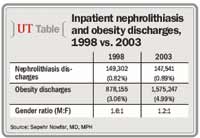Article
Nephrolithiasis: Gender discrepancy gap is narrowing
Traditionally, nephrolithiasis is considered more prevalent in males than females; a ratio of 3:1 has been described for this discrepancy. However, this gap appears to be narrowing, researchers say, and additional factors must be considered to further our understanding of stone risk.

Key Points
San Diego-Traditionally, nephrolithiasis is considered more prevalent in males than females; a ratio of 3:1 has been described for this discrepancy. However, this gap appears to be narrowing, researchers say, and additional factors must be considered to further our understanding of stone risk.
Researchers at the University of California, San Diego, presented data obtained from the National Inpatient Sample (NIS) database relating to the incidence of stone disease with respect to gender and obesity. The authors, led by Roger L. Sur, MD, hypothesized that the increased risk of stone disease in women is related to an increase in the incidence of obesity, which has emerged as a national epidemic and is another well-established risk factor for nephrolithiasis.
The NIS database includes approximately 20% of all admissions to U.S. hospitals. In the current study, first author Sepehr Nowfar, MD, MPH, a resident at UC San Diego, and colleagues queried the database for all admissions assigned the primary ICD-9 code 592.0 (renal calculus) or 592.1 (ureteral calculus) between 1998 and 2003. A statistical analysis was performed to examine changes over time with respect to stone prevalence, gender, and obesity.
Increases in obesity, nephrolithiasis seen

While a univariate analysis between nephrolithiasis and stone disease did not demonstrate a clinically significant relationship, a multivariate analysis clearly demonstrated a connection between nephrolithiasis and obesity (OR= 1.22, 95% CI: 1.20-1.23, p<.001) when controlling for age, gender, and comorbidites (diabetes and hypertension). In fact, further analysis demonstrated that "obese females appear to have a greater risk for urinary stones as compared to non-obese females," Dr. Nowfar said (OR=1.35, 95% CI: 1.33-1.37, p<.001).
It is possible, then, that the increase in nephrolithiasis prevalence in women in this study could be accounted for by a disproportionate increase in obesity in women as compared to men. The authors further note that this relationship will be better elucidated in the future as further data are accumulated regarding the effect of treating obesity on the incidence of stone disease.





